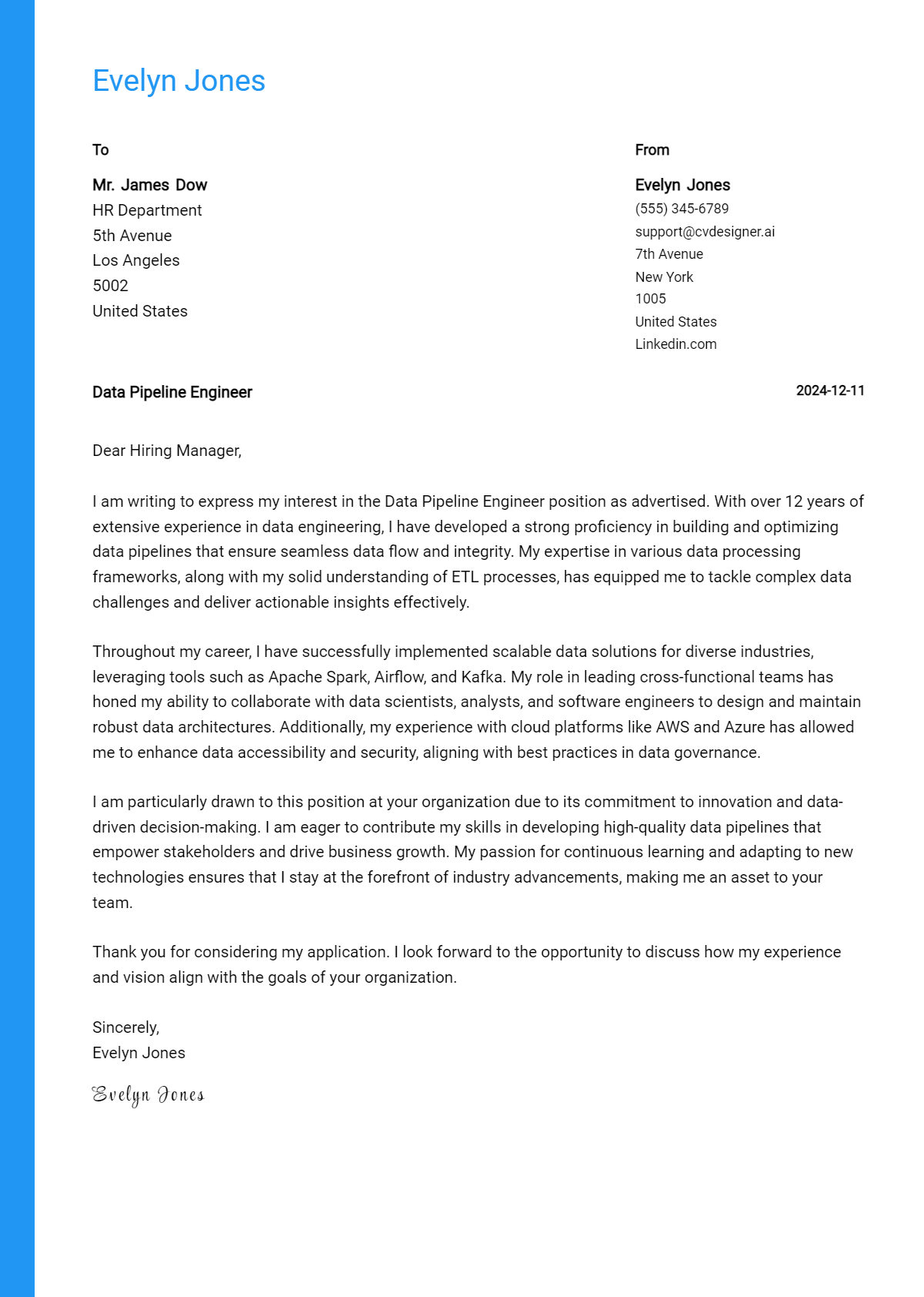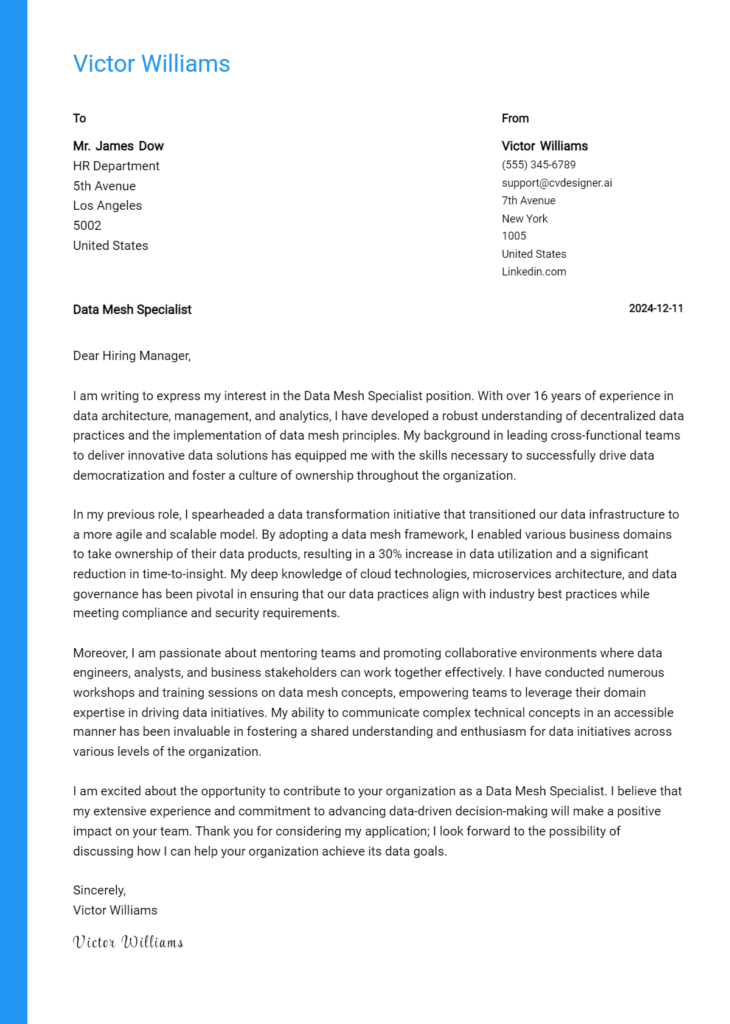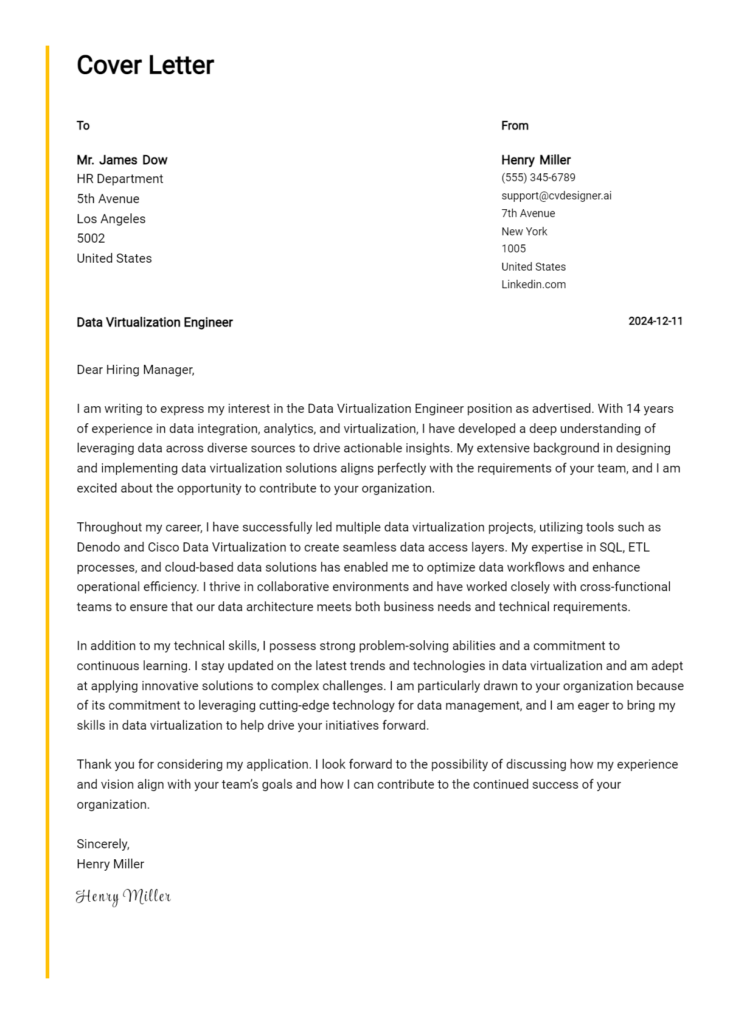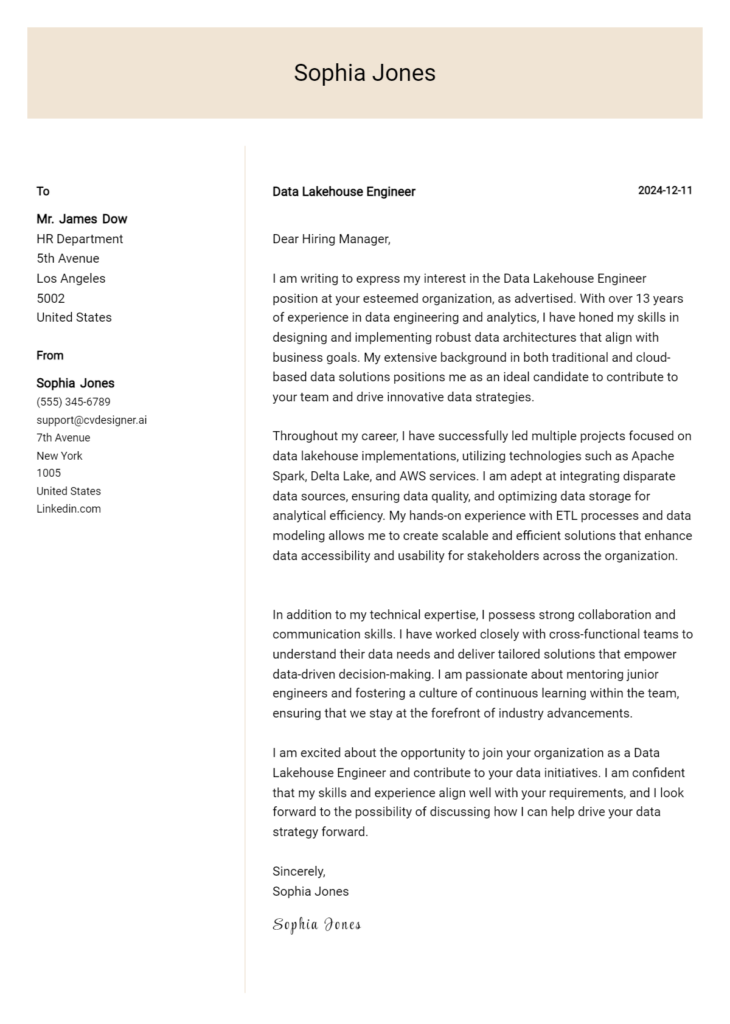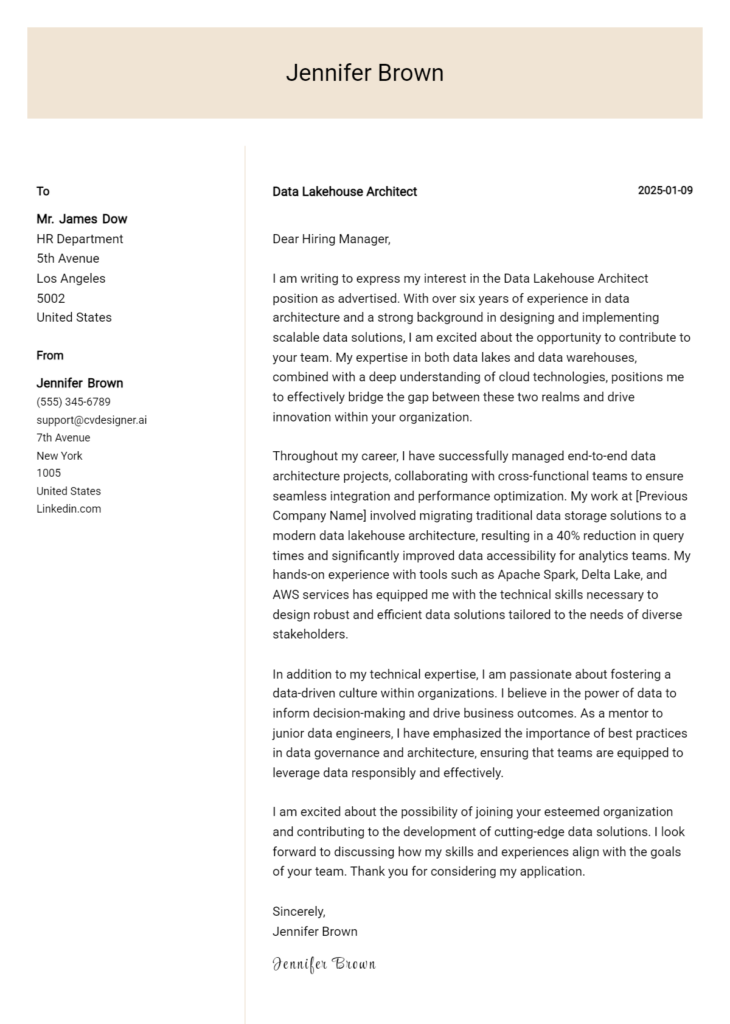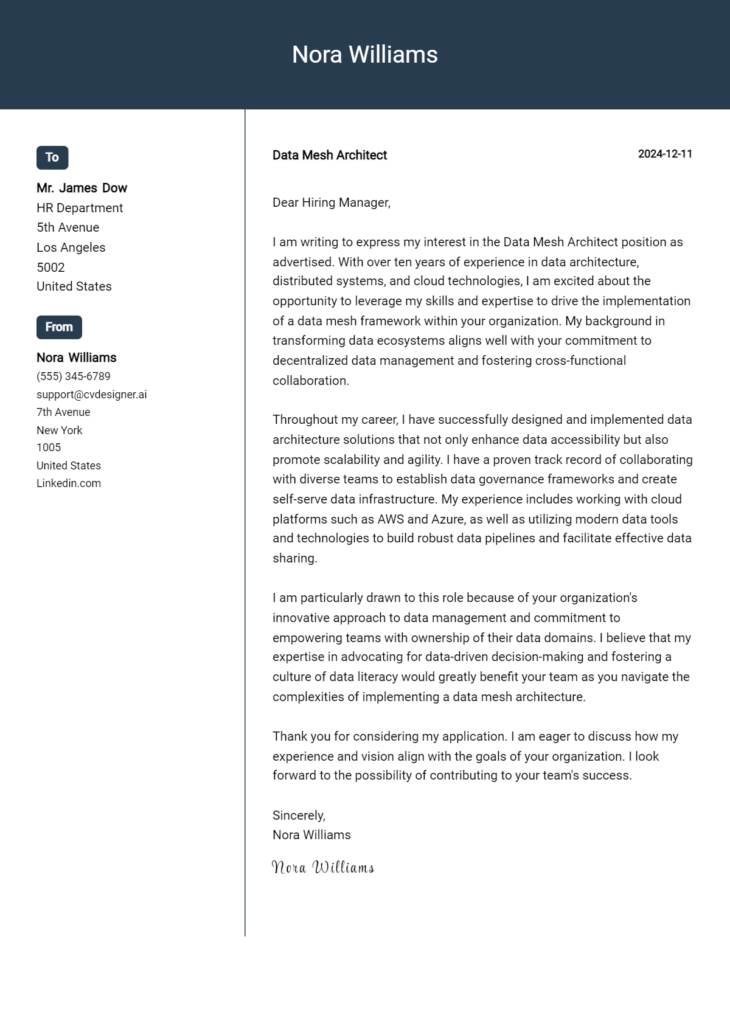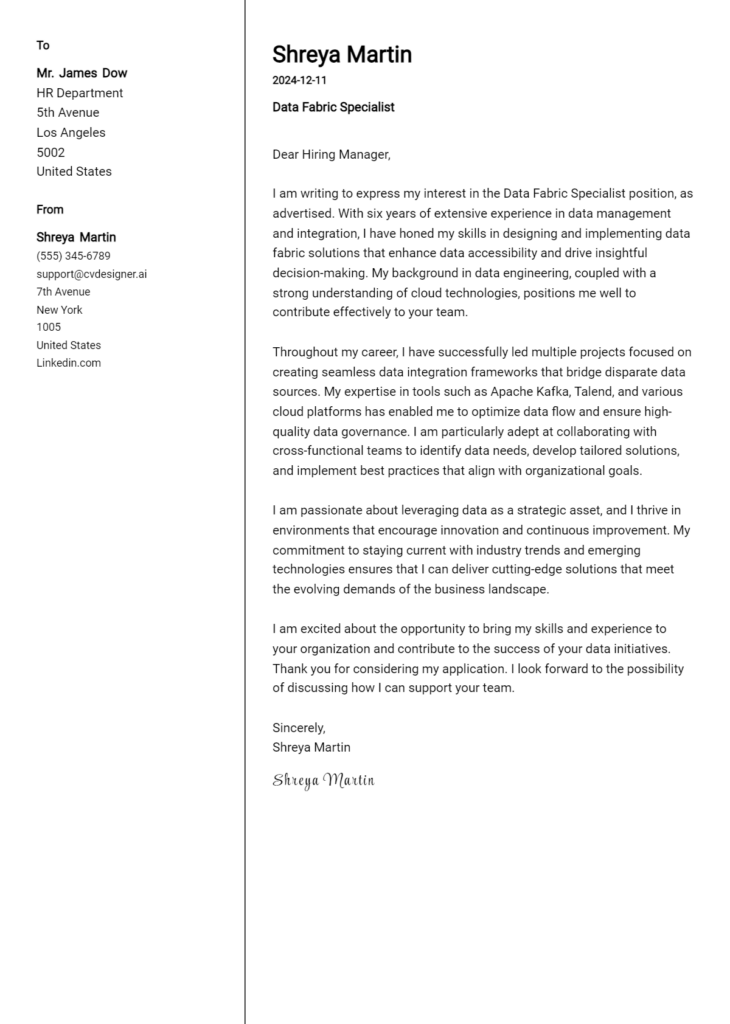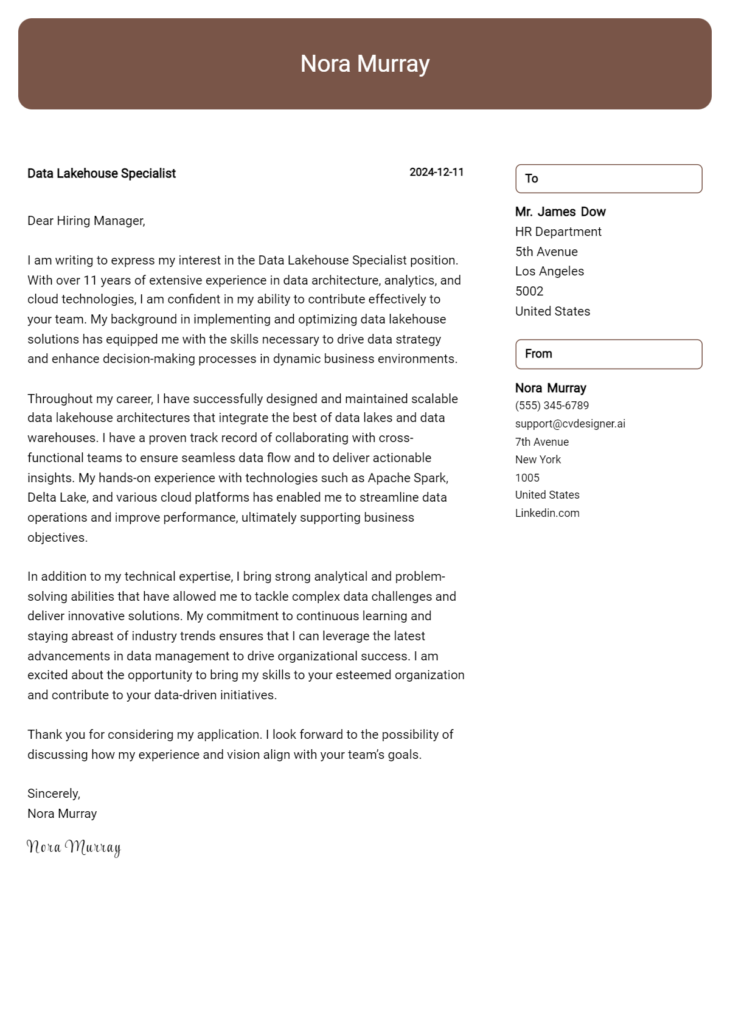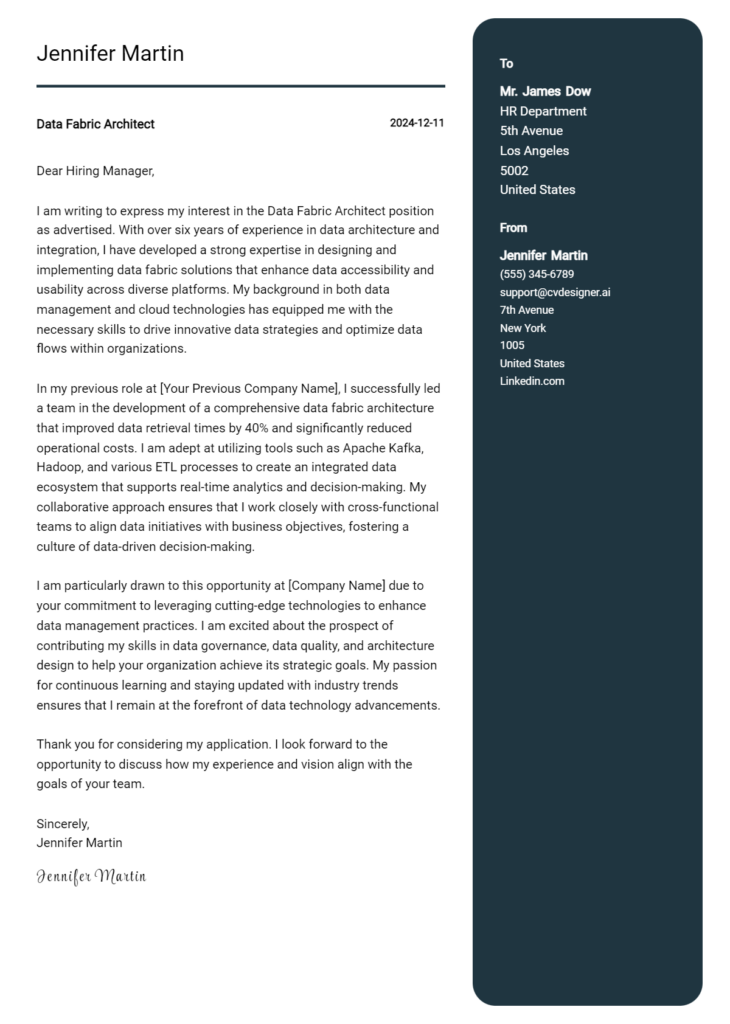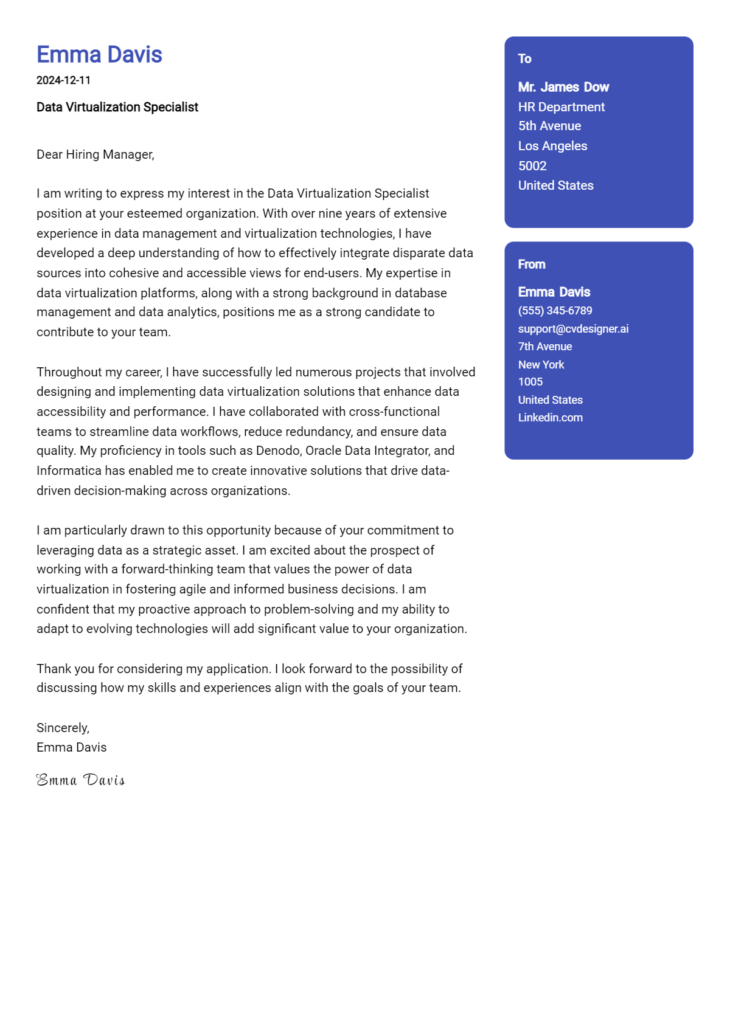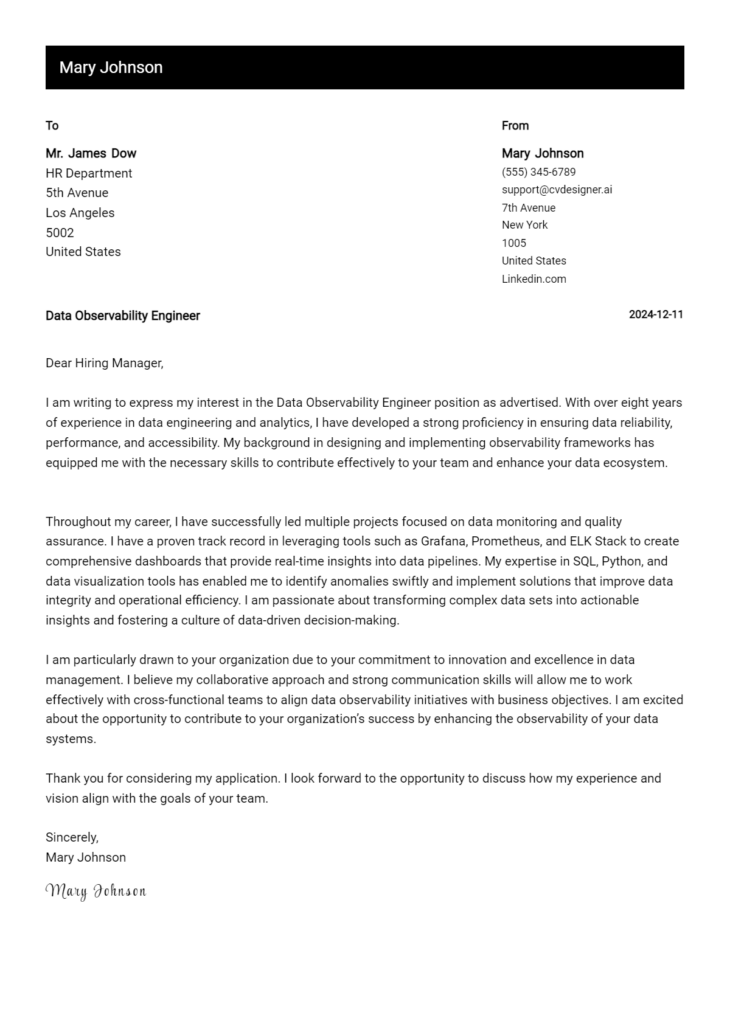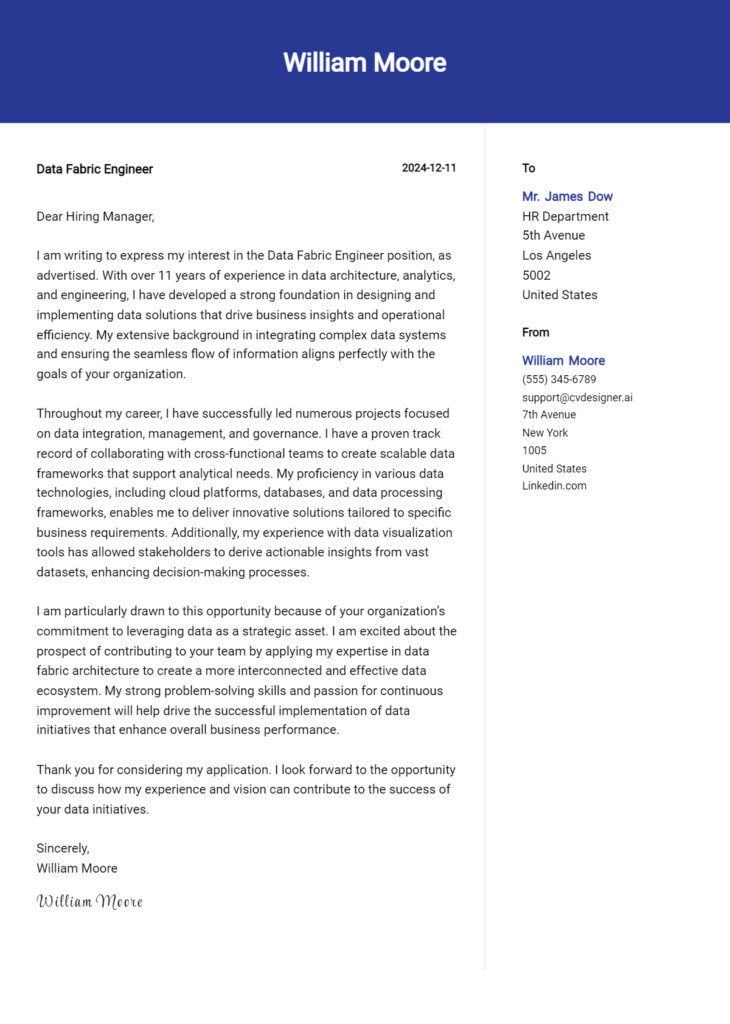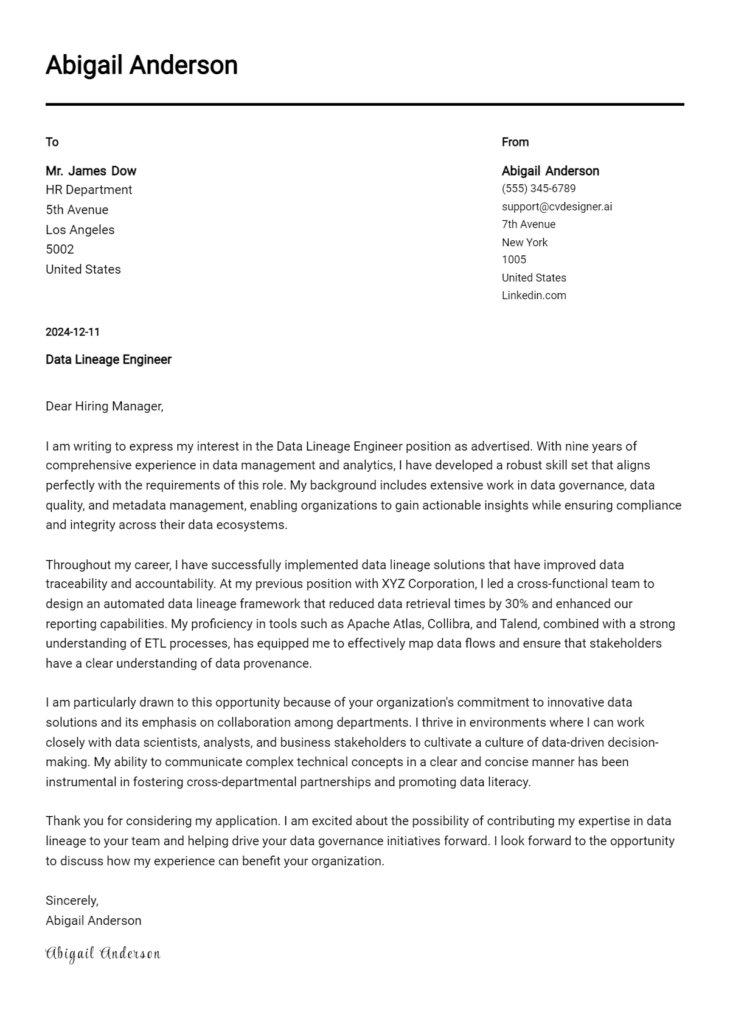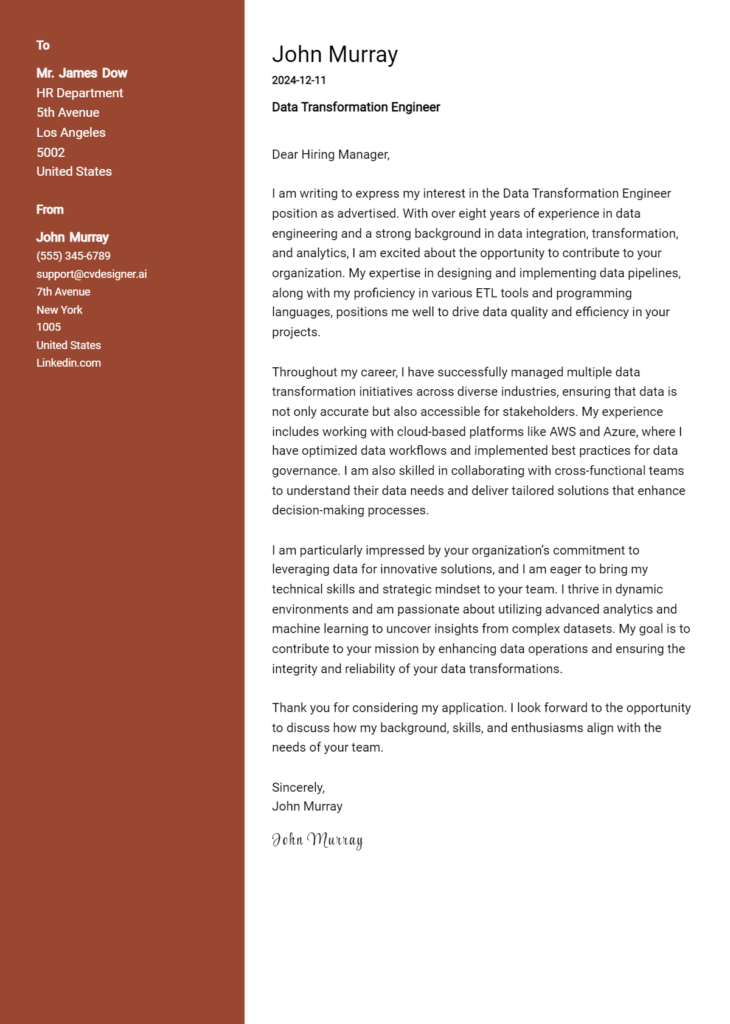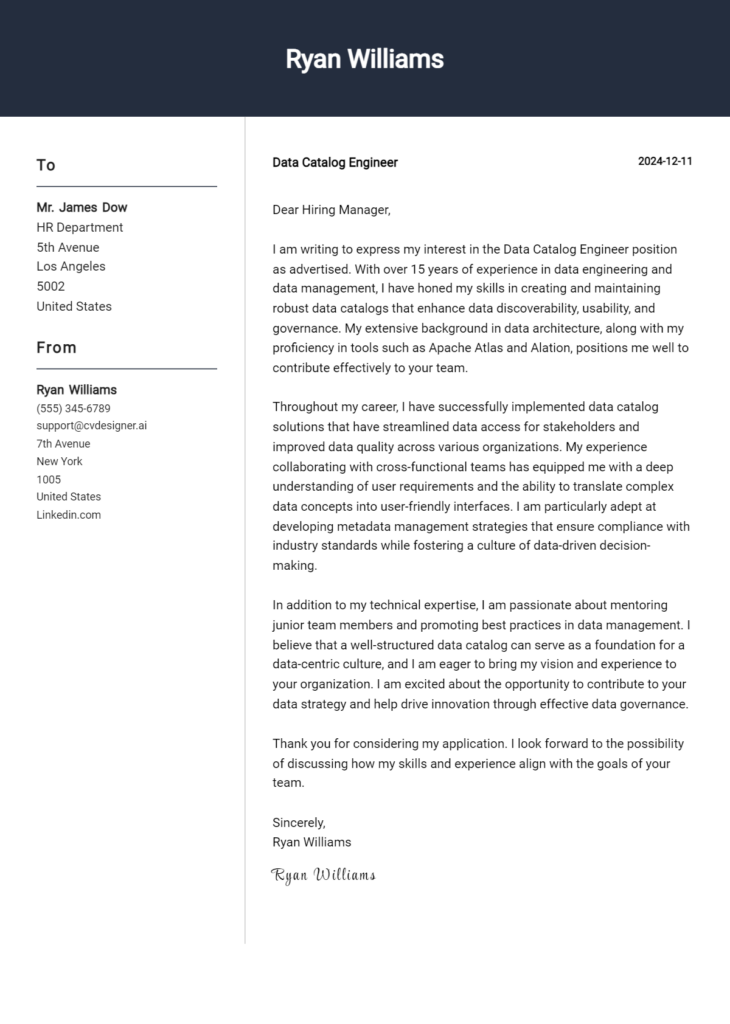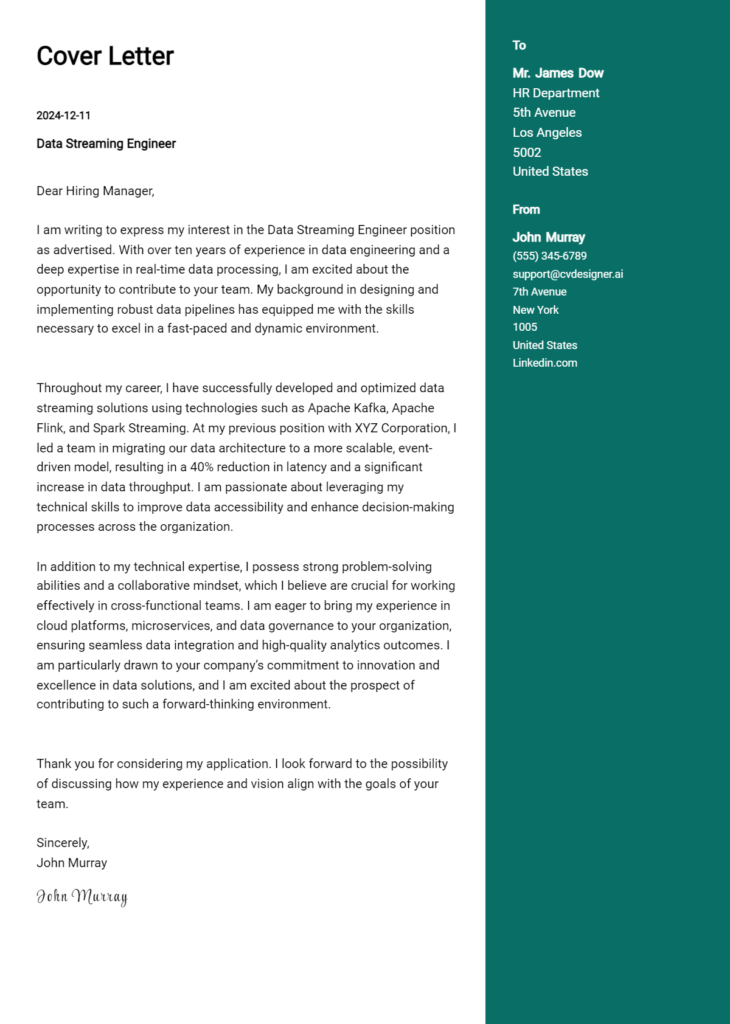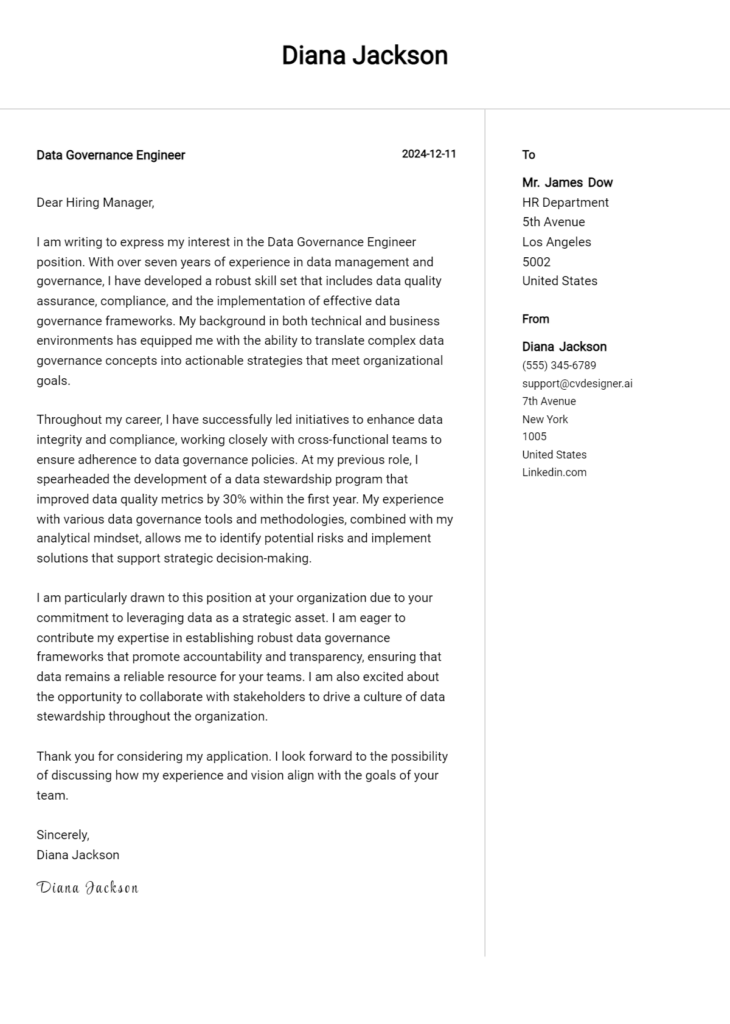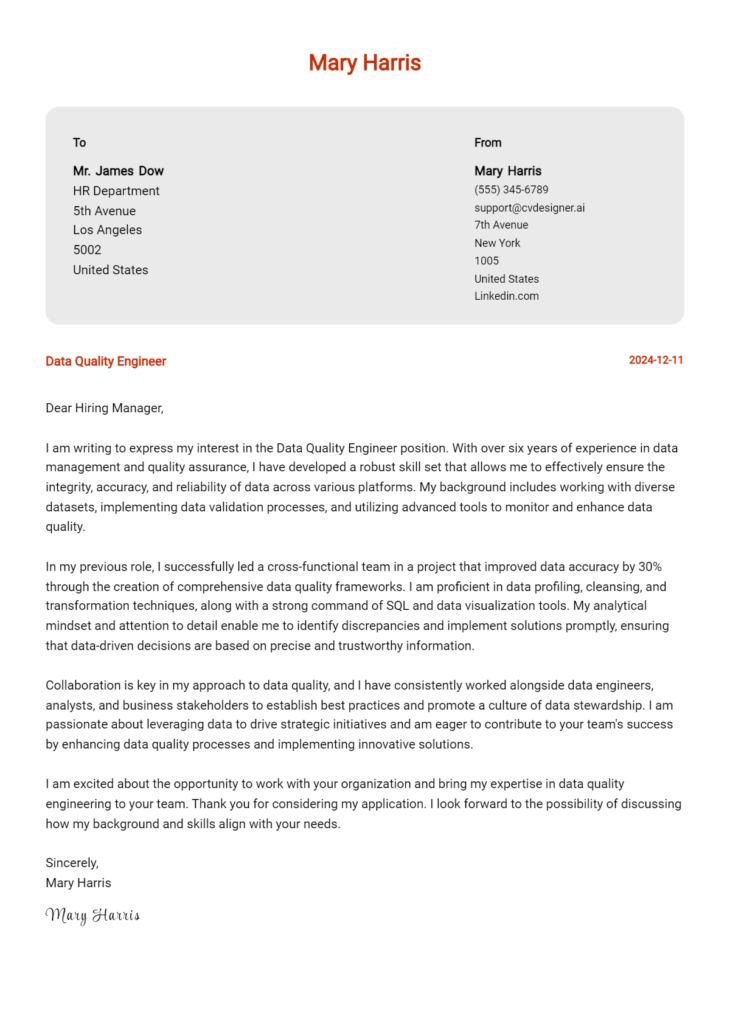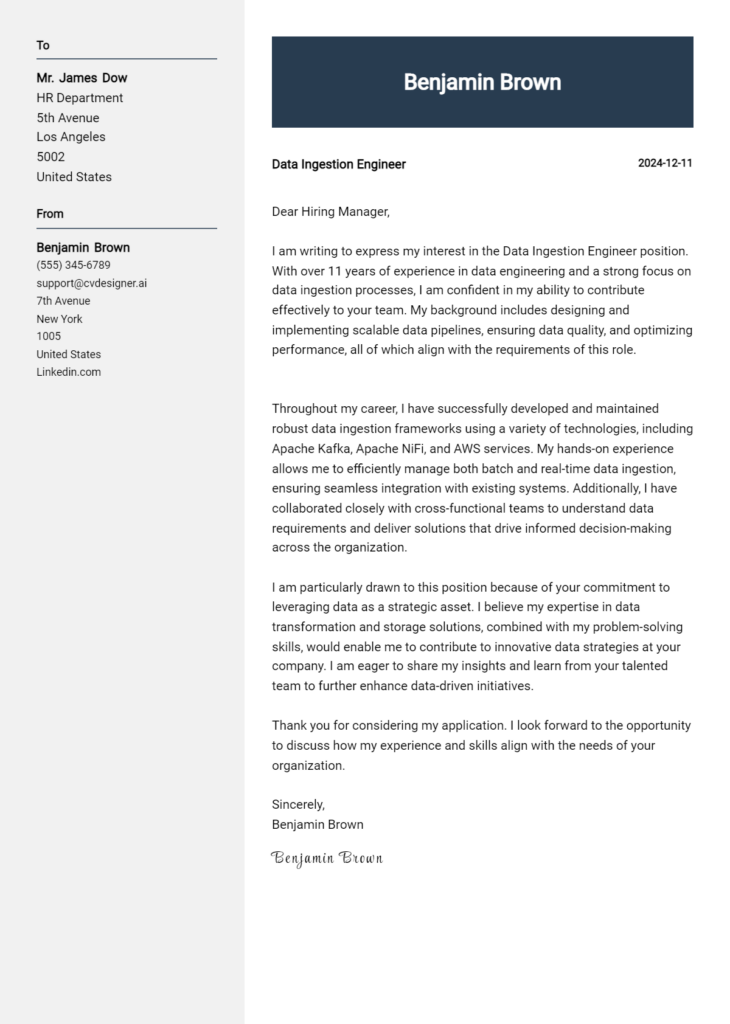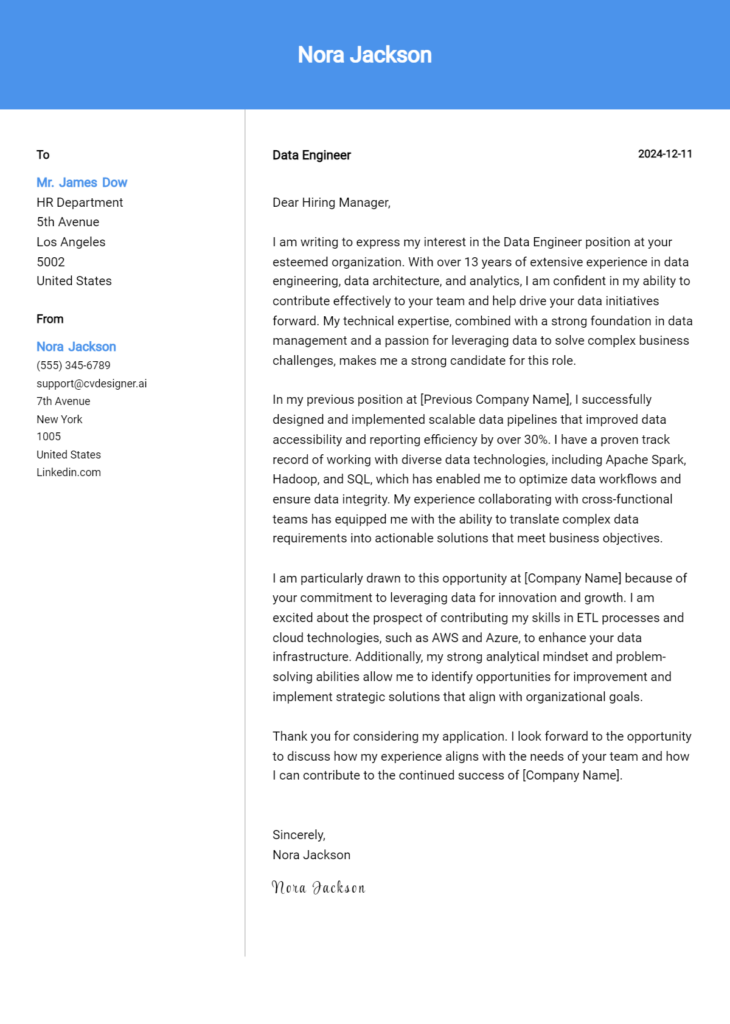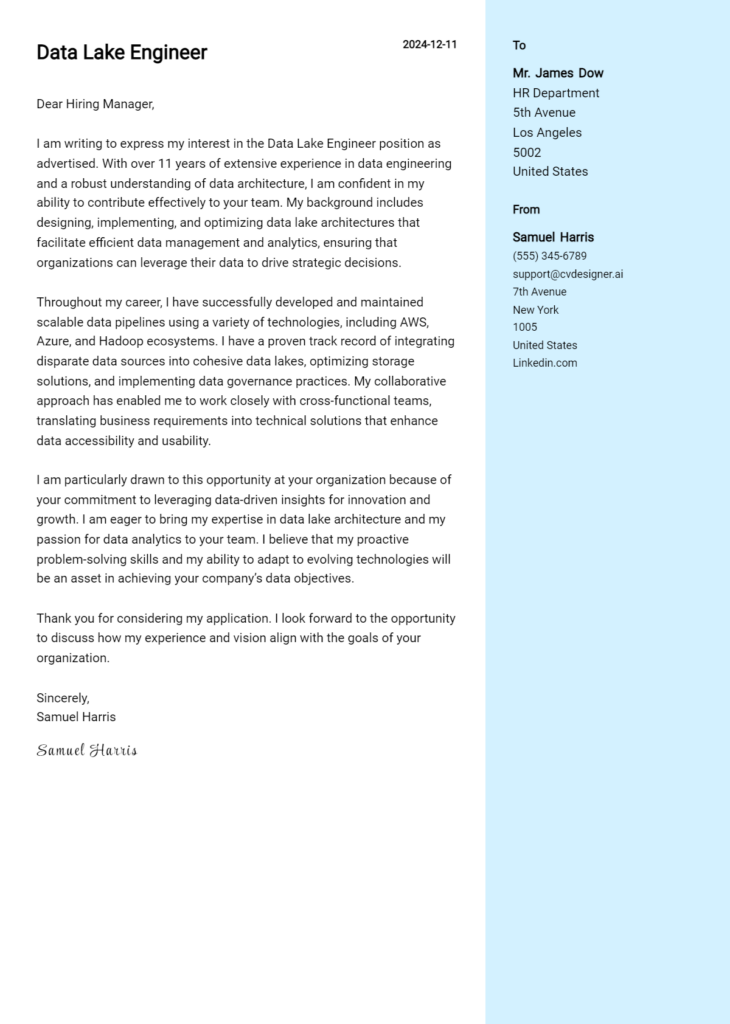Data Pipeline Engineer Cover Letter Examples
Explore additional Data Pipeline Engineer cover letter samples and guides and see what works for your level of experience or role.
How to Format a Data Pipeline Engineer Cover Letter?
Crafting a compelling cover letter is essential for a Data Pipeline Engineer, as it serves as your first opportunity to demonstrate not only your technical skills but also your ability to communicate complex ideas effectively. Proper formatting reflects your attention to detail and organizational skills—traits that are vital in managing data workflows and ensuring seamless data integration. A well-structured cover letter captures the hiring manager's attention and sets the tone for the rest of your application.
In this guide, we'll outline how to format your cover letter, focusing on components specifically relevant to a Data Pipeline Engineer role, including:
- Cover Letter Header
- Cover Letter Greeting
- Cover Letter Introduction
- Cover Letter Body
- Cover Letter Closing
Each section is crucial for presenting your qualifications and professionalism. Let’s delve into the specifics of each part to help you create an outstanding cover letter that resonates with potential employers.
Importance of the Cover Letter Header for a Data Pipeline Engineer
The header of a cover letter is a critical component that establishes a professional tone and provides essential information at a glance. For a Data Pipeline Engineer, clarity and professionalism in the header are particularly important as they reflect the candidate's attention to detail and organizational skills—key attributes for anyone working with data infrastructures. A well-structured header should include the applicant's contact information, the date, and the recipient's details, ensuring that the letter is easy to navigate and presents the candidate in the best light.
Strong Example
John Doe 1234 Data Lane Data City, DS 12345 john.doe@email.com (123) 456-7890 October 1, 2023 Jane Smith Hiring Manager Tech Innovations Inc. 5678 Tech Avenue Innovation City, IN 67890
Weak Example
john d email@example.com 10/1/23 jane manager co.
The Importance of a Greeting in Your Data Pipeline Engineer Cover Letter
The greeting of your cover letter is a crucial element that sets the tone for the entire document. A well-crafted greeting demonstrates professionalism and shows that you have taken the time to personalize your application. By addressing the hiring manager directly, you create an immediate connection and convey your genuine interest in the position. To avoid generic greetings such as "To Whom It May Concern," which can come off as impersonal and disengaged, take the time to research the recipient's name. This extra effort can significantly enhance your letter's impact. Here are some examples of strong and weak greetings for a Data Pipeline Engineer cover letter:
Strong Greeting Example
Dear Ms. Johnson,
Weak Greeting Example
To Whom It May Concern,
The Importance of a Well-Crafted Cover Letter Introduction for a Data Pipeline Engineer
A compelling cover letter introduction is essential for a Data Pipeline Engineer as it serves as the candidate's first impression on the hiring manager. This opening statement should not only capture attention but also effectively convey the applicant's enthusiasm for the role and highlight relevant skills or accomplishments. A strong introduction can set the tone for the rest of the cover letter, making it more likely for the candidate to stand out in a competitive job market. Conversely, a weak introduction may fail to engage the reader, potentially resulting in the application being overlooked.
Strong Example:
Dear [Hiring Manager's Name], As a passionate Data Pipeline Engineer with over five years of experience in designing and optimizing data workflows, I was excited to discover the opportunity at [Company Name]. My expertise in Apache Kafka and ETL processes, combined with a proven track record of reducing data processing times by 30%, aligns perfectly with your team's goal of enhancing data integrity and accessibility. I am eager to contribute my skills to propel your data initiatives forward.
Weak Example:
To whom it may concern, I am applying for the Data Pipeline Engineer position. I have some experience in data processing and I think I could do well in this job. I would like to work for your company.
Purpose of the Cover Letter Body for a Data Pipeline Engineer
The body of a cover letter for a Data Pipeline Engineer serves as a critical platform for candidates to present their relevant skills, experiences, and the unique value they can bring to the prospective company. This section allows candidates to highlight specific projects or accomplishments that demonstrate their expertise in building, maintaining, and optimizing data pipelines. By showcasing technical skills alongside real-world applications, candidates can effectively illustrate how their past experiences align with the needs of the company, making a compelling case for their potential contributions.
Strong Example
Dear Hiring Manager, I am excited to apply for the Data Pipeline Engineer position at XYZ Corp. In my previous role at ABC Technologies, I successfully designed and implemented an ETL process that reduced data processing time by 40%, enabling real-time analytics for our marketing team. My project involved integrating various data sources, including PostgreSQL and MongoDB, which improved data accuracy and accessibility. Additionally, I collaborated with cross-functional teams to migrate our data infrastructure to AWS, leading to a cost reduction of 30% on data storage and processing. I am eager to bring my expertise in Apache Kafka and Spark to your team and contribute to optimizing data workflows at XYZ Corp. Sincerely, John Doe
Weak Example
Dear Hiring Manager, I am writing to apply for the Data Pipeline Engineer position. I have some experience with data pipelines and have worked on projects that involved data. I think I would be a good fit for your company because I am a fast learner and can work with different technologies. I hope to contribute to your team. Best, Jane Smith
Importance of the Cover Letter Closing for a Data Pipeline Engineer
The closing paragraph of a cover letter is crucial as it serves to summarize your qualifications, reiterate your enthusiasm for the role, and encourage the hiring manager to take the next steps, such as reviewing your resume or scheduling an interview. A strong closing leaves a memorable impression and reinforces your suitability for the position, while a weak closing might diminish the overall impact of your application.
Strong Example
Thank you for considering my application for the Data Pipeline Engineer position. With my extensive experience in building scalable data pipelines and my passion for data-driven solutions, I am excited about the opportunity to contribute to your team at [Company Name]. I look forward to the possibility of discussing how my skills align with your needs. Please feel free to review my resume for more details, and I hope we can schedule a time to meet soon.
Weak Example
I guess that’s it. I hope you like my application. If you want to, you can look at my resume. Maybe we can talk later.
Crafting an effective cover letter for a Data Pipeline Engineer position is essential to stand out in a competitive job market. This document serves as your opportunity to showcase not only your technical skills but also your problem-solving abilities, understanding of the Software Development Life Cycle (SDLC), teamwork, and passion for continuous learning. By following these tips, candidates can create a compelling cover letter that resonates with hiring managers.
Tips for Writing an Effective Cover Letter for Data Pipeline Engineer
Highlight Your Technical Skills
Clearly articulate your technical skills related to data engineering, such as proficiency in programming languages (e.g., Python, Java), experience with data warehousing solutions (e.g., Snowflake, Redshift), and familiarity with ETL tools (e.g., Apache NiFi, Talend). Use specific examples to demonstrate how you have utilized these skills in previous projects.Showcase Problem-Solving Abilities
Employers value candidates who can tackle complex challenges. Include a brief narrative about a specific problem you faced in a data pipeline project and the innovative solution you implemented. Highlight the impact of your solution on project outcomes, such as improved data reliability or processing speed.Demonstrate SDLC Knowledge
Discuss your understanding of the Software Development Life Cycle and how it relates to data engineering. Describe your experience in various stages, such as requirements gathering, design, implementation, testing, and maintenance. This will show your holistic understanding of the development process and your ability to work collaboratively with cross-functional teams.Emphasize Teamwork and Collaboration
Data pipeline engineers often work in teams alongside data scientists, analysts, and other engineers. Share examples of successful collaborations where your contributions led to improved results. Highlight your communication skills and how you facilitate teamwork, ensuring all members are aligned and informed throughout the project lifecycle.Express a Passion for Continuous Learning
The field of data engineering is constantly evolving. Mention any recent courses, certifications, or self-directed learning experiences that showcase your commitment to staying current with industry trends and technologies. This not only demonstrates your initiative but also signals to potential employers that you are adaptable and eager to grow within the role.
By incorporating these elements into your cover letter, you'll increase your chances of making a strong impression on potential employers. If you need additional assistance, consider using our cover letter templates or our cover letter builder to streamline the process.
Common Mistakes to Avoid in a Data Pipeline Engineer Cover Letter
Crafting an effective cover letter is essential for standing out in the competitive field of data engineering. Avoiding common mistakes can significantly enhance your chances of making a positive impression on potential employers. Here are some missteps to watch out for when writing your cover letter for a Data Pipeline Engineer position, along with tips on how to sidestep them:
Being Too Generic: Tailor your cover letter to the specific job and company. Research the organization and mention how your skills align with their goals.
Neglecting the Format: A poorly formatted cover letter can be off-putting. Follow a clean and professional cover letter format to ensure readability.
Focusing Only on Responsibilities: Instead of just listing past job duties, emphasize your achievements and how they relate to the data pipeline role.
Using Jargon Excessively: While technical terms are important, overloading your cover letter with jargon can make it difficult to read. Balance technical language with clear explanations.
Ignoring the Call to Action: Always include a strong closing statement that encourages the employer to reach out for further discussion.
Failing to Proofread: Typos and grammatical errors can undermine your professionalism. Always proofread your letter multiple times or have someone else review it.
Not Providing Examples: Include specific examples of your past work that demonstrate your expertise in data pipelines. This adds credibility to your claims.
By avoiding these pitfalls and utilizing resources such as cover letter examples, you can create a compelling cover letter that showcases your qualifications and makes a lasting impression.
Cover Letter FAQs for Data Pipeline Engineer
What should I include in my cover letter for a Data Pipeline Engineer position?
In your cover letter, start with a brief introduction that includes the position you’re applying for and how you found out about it. Highlight your relevant technical skills, such as proficiency in programming languages like Python or Java, experience with ETL processes, and knowledge of data warehousing solutions. Be sure to mention any experience with cloud platforms, such as AWS or Google Cloud, and tools like Apache Kafka or Airflow. Additionally, provide examples of past projects where you designed or optimized data pipelines, emphasizing your problem-solving skills and ability to work with cross-functional teams. Finally, express your enthusiasm for the company and how your skills align with its goals.
How long should my cover letter be for a Data Pipeline Engineer job?
Your cover letter should ideally be one page long, consisting of three to four paragraphs. This length allows you to convey your qualifications and enthusiasm without overwhelming the reader. Aim for around 250-400 words total. Start with a compelling introduction, followed by a body where you delve into your skills and experience relevant to the Data Pipeline Engineer role. Conclude with a strong closing statement that reiterates your interest in the position and invites the hiring manager to discuss your application further. Being concise yet informative will help you stand out among other candidates.
Should I tailor my cover letter for each Data Pipeline Engineer application?
Yes, tailoring your cover letter for each application is crucial. Each company has its unique culture, values, and specific requirements for the Data Pipeline Engineer position. By customizing your cover letter, you can demonstrate that you’ve researched the company and understand its challenges. Use keywords from the job description and align your experiences with the company’s needs. Mention specific projects or technologies they use that resonate with your background. This tailored approach shows commitment and increases your chances of catching the hiring manager's attention, making your application more compelling.
How can I showcase my technical skills in my cover letter?
To effectively showcase your technical skills in your cover letter, be specific about the tools and technologies you have experience with. Instead of simply listing skills, provide context by mentioning relevant projects or achievements. For instance, if you have experience with Apache Spark, discuss how you used it to process large datasets efficiently. Highlight quantifiable outcomes, such as improved data processing times or reduced costs. Additionally, don’t forget to mention soft skills like communication and teamwork, which are essential for collaborating with data scientists and business stakeholders. By blending technical prowess with real-world applications, you can present a well-rounded picture of your capabilities.
Build your Cover Letter in minutes
Use an AI-powered cover letter builder and have your letter done in 5 minutes. Just select your template and our software will guide you through the process.

